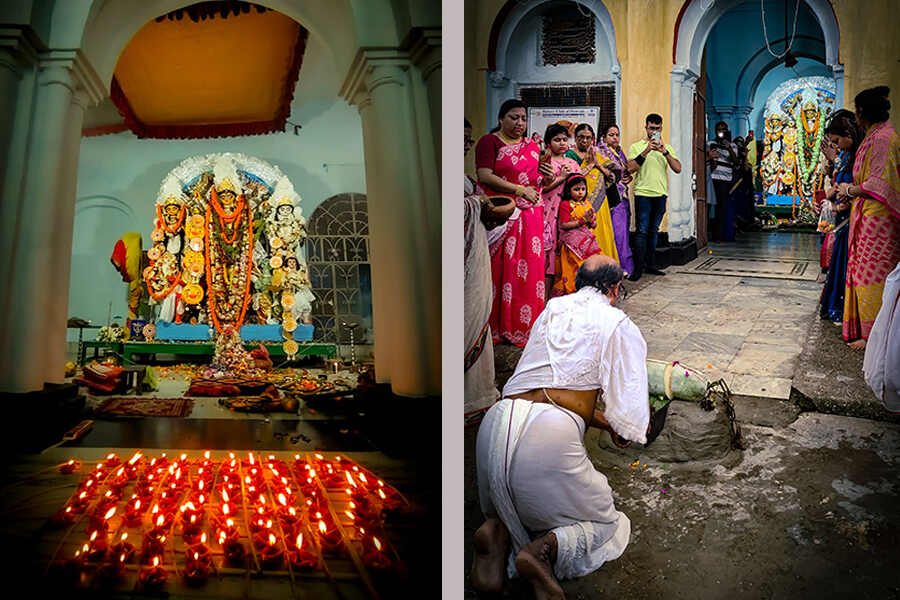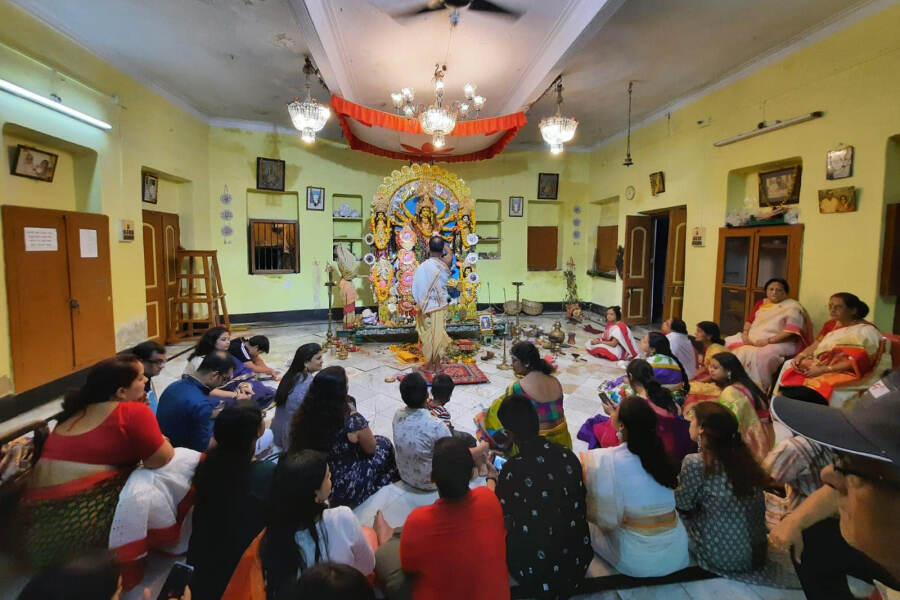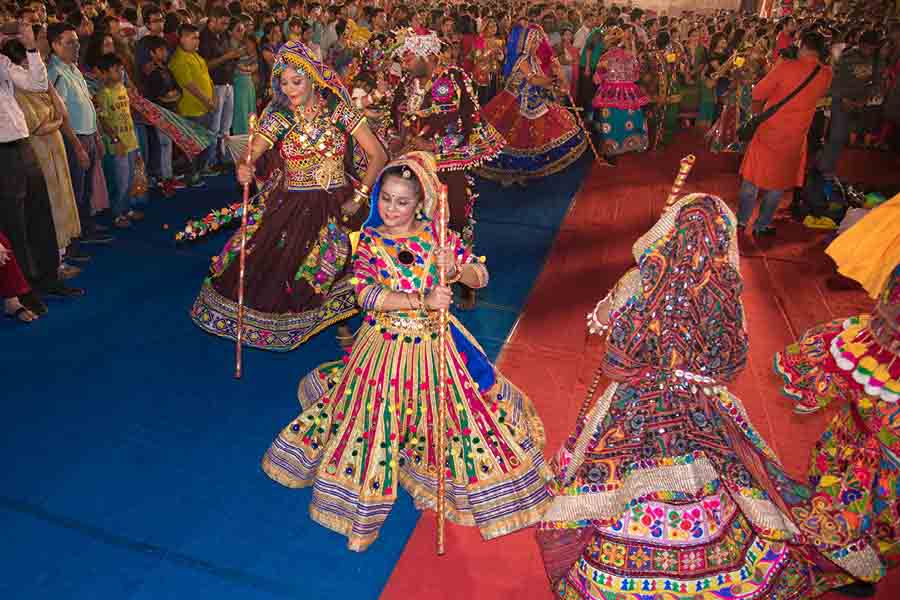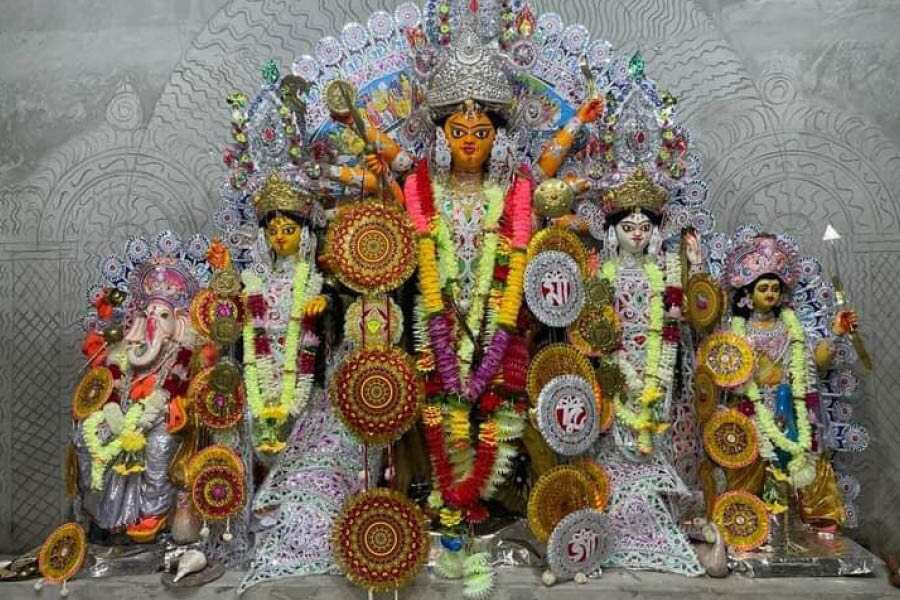Kalibabur Bazaar in central Howrah is a well-known old market. Equally old or even older is the Durga puja conducted by the descendants of the original owner of this market — Kali Bandopadhyay. The Banerjee family conducts two Durga pujas within their premises jointly.
The original puja is over 300 years old, where the goddess is adorned with shola (pith) decorations, while the other puja, which dates back to 100 years, is decked out in golden foil.

108 diyas lit for Sandhi Puja and (right) pumpkin sacrifice ritual at the Bandopadhyay residence
The family’s ancestor, Girish Bandopadhyay, who hailed from Nadia, was the zamindar of the place where the present-day Fort William stands. After Fort William was built, the Bandyopadhyay family was allotted land in the Howrah Maidan area near what is now Kalibabur Bazar.
Kathamo (structure) puja of the family starts on the day after Janmashtami. At present, the eighth and ninth generations of the family conduct the puja. The puja is conducted as per Vaishnav rituals, as the griha debata or family deity is Gopal. Bodhon starts from the day after Mahalaya.
The same day, the ritual of Chandipath also commences. Mahalaya onwards, all family members eat vegetarian food till Bijoya Dashami. No animal sacrifice takes place in this puja. Instead, a chalkumro (white gourd) is sacrificed. Earlier, the clay platform on which the chalkumro was sacrificed would be broken down and the clay used by household members to smear on each other’s bodies while dancing to the beats of the dhak (drum). This ritual was known as ‘Kadamati Khela’. However, it has been discontinued in recent times.

Durga Puja is a grand get-together for the Bandopadhyay family members of central Howrah
The priests who perform the puja rituals have been doing so since generations. The family of Ramgopal Mukhopadhyay who conducts the puja happens to be their ‘guru bangsha’ as well. Even now, the major decisions of the family are taken after consulting the descendants of the ‘guru bangsha’. The priest and his team conduct both the Durga pujas. At present, Ramgopal Mukhopadhyay’s grandson, Shyamaprasad Mukhopadhyay, is in charge of the Durga Puja.

Kumari Puja on Nabami at the puja. The family performs Kumari Puja on both Ashtami and Nabami
The nabapatrika rituals are conducted at the Bandyopadhyay family’s home. Earlier, water from the Ganges was used in the rituals. However, later, a well was constructed on the premises of Bandyopadhyay residence after performing several rituals. The water of the well is used exclusively for all rituals of Durga Puja, including preparation of bhog offering to the deities. It is not used for any daily household purposes.
The food offerings to the goddess comprise annabhog (rice preparations) as usually done in Brahmin families. It consists of plain rice, khichuri, pulao along with dal and several fried vegetables like potato, pumpkin, pointed gourd and coconut. Several sweets are offered to the goddess too. Earlier, they used to be prepared in the house but is now ordered from the market. Among sweets, a special payesh is made with sooji with baked banana pieces inside it. On Dashami, the goddess is offered panta bhat (fermented rice) along with kochur shak.

‘Sindoor khela’ is conducted after Sandhi Puja as well as on Dashami
The puja sankalpa of the Bandyopadhyay is done by a senior woman member of the house known as the brati. For the last 12 years, Krishna Bandyopadhyay of the family is performing the role of the brati. Such persons take bath in the Ganges on Mahalaya, fast from that day throughout the puja in the daytime till Dashami, consume self-cooked habisshi (boiled rice with ghee) and coconut water in the evening after arati.
Kumari Puja of the house takes place on both Ashtami and Navami. On Ashtami several kumaris (girls yet to reach puberty) are worshipped by many household members. On Navami, however, only the brati performs a single Kumari Puja.
Interestingly, sindoor khela takes place after Sandhi Puja as well on Bijoya Dashami after boron rituals. The sindoor khela on Sandhi Puja is a low-profile affair on Sandhi Puja and a grand affair on Bijoya Dashami.

The two deities of the Bandopadhyay family are carried together on Bijoya Dashami for immersion in the Ganga
On Dashami, both the deities are immersed together in the Ganga after carrying them manually without any transportation. First, the Durga decked out in shola is immersed and then the other deity. Earlier, immersion used to take place from twin boats, which has been stopped for over 10 years because of non-availability of suitable boats. Interestingly, the boatmen usually used to be Muslims who used to embrace the house members after immersion.
The Bandyopadhyay family members consume meals in the form of a huge get-together on the three Puja days as a mark of eternal bonding in the family.



